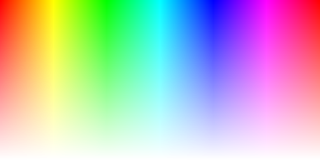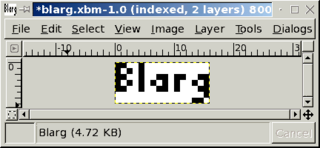Related Research Articles

In computer graphics, alpha compositing or alpha blending is the process of combining one image with a background to create the appearance of partial or full transparency. It is often useful to render picture elements (pixels) in separate passes or layers and then combine the resulting 2D images into a single, final image called the composite. Compositing is used extensively in film when combining computer-rendered image elements with live footage. Alpha blending is also used in 2D computer graphics to put rasterized foreground elements over a background.

Portable Network Graphics is a raster-graphics file format that supports lossless data compression. PNG was developed as an improved, non-patented replacement for Graphics Interchange Format (GIF)—unofficially, the initials PNG stood for the recursive acronym "PNG's not GIF".
PCX, standing for PiCture eXchange, is an image file format developed by the now-defunct ZSoft Corporation of Marietta, Georgia, United States. It was the native file format for PC Paintbrush and became one of the first widely accepted DOS imaging standards, although it has since been succeeded by more sophisticated image formats, such as BMP, JPEG, and PNG. PCX files commonly store palette-indexed images ranging from 2 or 4 colors to 16 and 256 colors, although the format has been extended to record true-color (24-bit) images as well.
PackBits is a fast, simple lossless compression scheme for run-length encoding of data.

In computer graphics and digital photography, a raster graphic represents a two-dimensional picture as a rectangular matrix or grid of pixels, viewable via a computer display, paper, or other display medium. A raster is technically characterized by the width and height of the image in pixels and by the number of bits per pixel. Raster images are stored in image files with varying dissemination, production, generation, and acquisition formats.
Run-length encoding (RLE) is a form of lossless data compression in which runs of data are stored as a single data value and count, rather than as the original run. This is most efficient on data that contains many such runs, for example, simple graphic images such as icons, line drawings, Conway's Game of Life, and animations. For files that do not have many runs, RLE could increase the file size.
Tag Image File Format or Tagged Image File Format, commonly known by the abbreviations TIFF or TIF, is an image file format for storing raster graphics images, popular among graphic artists, the publishing industry, and photographers. TIFF is widely supported by scanning, faxing, word processing, optical character recognition, image manipulation, desktop publishing, and page-layout applications. The format was created by the Aldus Corporation for use in desktop publishing. It published the latest version 6.0 in 1992, subsequently updated with an Adobe Systems copyright after the latter acquired Aldus in 1994. Several Aldus or Adobe technical notes have been published with minor extensions to the format, and several specifications have been based on TIFF 6.0, including TIFF/EP, TIFF/IT, TIFF-F and TIFF-FX.
OpenEXR is a high-dynamic range, multi-channel raster file format, released as an open standard along with a set of software tools created by Industrial Light & Magic (ILM), under a free software license similar to the BSD license.
The BMP file format or bitmap, is a raster graphics image file format used to store bitmap digital images, independently of the display device, especially on Microsoft Windows and OS/2 operating systems.

RGBA stands for red green blue alpha. While it is sometimes described as a color space, it is actually a three-channel RGB color model supplemented with a fourth alpha channel. Alpha indicates how opaque each pixel is and allows an image to be combined over others using alpha compositing, with transparent areas and anti-aliasing of the edges of opaque regions.

Interleaved Bitmap (ILBM) is an image file format conforming to the Interchange File Format (IFF) standard. The format originated on the Amiga platform, and on IBM-compatible systems, files in this format or the related PBM format are typically encountered in games from late 1980s and early 1990s that were either Amiga ports or had their graphical assets designed on Amiga machines.
Truevision TGA, often referred to as TARGA, is a raster graphics file format created by Truevision Inc.. It was the native format of TARGA and VISTA boards, which were the first graphic cards for IBM-compatible PCs to support Highcolor/truecolor display. This family of graphic cards was intended for professional computer image synthesis and video editing with PCs; for this reason, usual resolutions of TGA image files match those of the NTSC and PAL video formats.

In computer graphics, the X Window System used X BitMap (XBM), a plain text binary image format, for storing cursor and icon bitmaps used in the X GUI. The XBM format is superseded by XPM, which first appeared for X11 in 1989.
Netpbm is an open-source package of graphics programs and a programming library. It is used mainly in the Unix world, where one can find it included in all major open-source operating system distributions, but also works on Microsoft Windows, macOS, and other operating systems.
An image file format is a file format for a digital image. There are many formats that can be used, such as JPEG, PNG, and GIF. Most formats up until 2022 were for storing 2D images, not 3D ones. The data stored in an image file format may be compressed or uncompressed. If the data is compressed, it may be done so using lossy compression or lossless compression. For graphic design applications, vector formats are often used. Some image file formats support transparency.
In computing, indexed color is a technique to manage digital images' colors in a limited fashion, in order to save computer memory and file storage, while speeding up display refresh and file transfers. It is a form of vector quantization compression.
The Apple Icon Image format (.icns) is an icon format used in Apple Inc.'s macOS. It supports icons of 16 × 16, 32 × 32, 48 × 48, 128 × 128, 256 × 256, 512 × 512 points at 1x and 2x scale, with both 1- and 8-bit alpha channels and multiple image states. The fixed-size icons can be scaled by the operating system and displayed at any intermediate size.
PVRTC and PVRTC2 are a family of lossy, fixed-rate texture compression formats used in PowerVR's MBX, SGX and Rogue technologies. The PVRTC algorithm is documented in Simon Fenney's paper "Texture Compression using Low-Frequency Signal Modulation" that was presented at Graphics Hardware 2003.
Ericsson Texture Compression (ETC) is a lossy texture compression technique developed in collaboration with Ericsson Research in early 2005. It was originally developed under the name iPACKMAN and based on an earlier compression scheme called iPACKMAN.
The Quite OK Image Format (QOI) is a specification for lossless image compression of 24-bit or 32-bit color raster (bitmapped) images, invented by Dominic Szablewski and first announced on 24 November 2021.
References
- ↑ .sgi MIME type not registered at IANA
- ↑ "CGImageSource.SupportedTypes". Claris FileMaker MBS Plug-in. MonkeyBread Software.
- ↑ Paul Haeberli (1996). "The SGI Image File Format 0.97". Silicon Graphics . Retrieved 2014-03-07.[ dead link ] Alt URL
- 1 2 3 James D. Murray; William van Ryper (April 1996). "SGI Image File Format File Format Summary" . Encyclopedia of Graphics File Formats, Second Edition. O'Reilly. ISBN 1-56592-161-5 . Retrieved 2014-03-07.
- ↑ Paul Haeberli (1996). "The SGI Image File Format 1.00". Silicon Graphics . Retrieved 2014-03-07.
- ↑ Lars Haglund (Feb 2006). "The SVT High Definition Multi Format Test Set" (PDF). SVT . Retrieved 2014-02-23.
- ↑ "SVT_MultiFormat/2160p50_CgrLevels_Master_SVTdec05". Video Quality Experts Group (VQEG). 2006. Retrieved 2014-03-01.
- ↑ Marta Mrak; Mislav Grgicb; Murat Kunt (2010). High-Quality Visual Experience: Creation, Processing and Interactivity of High-Resolution and High-Dimensional Video Signals. Signals and Communication Technology. Springer. pp. 147–154. ISBN 978-3-642-12802-8. LCCN 2010925849.